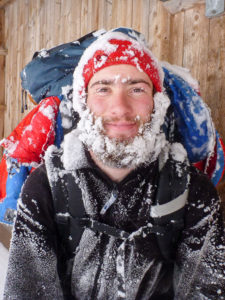This article previously appeared in the Winter 2012 Long Trail News.

In September 2011, my friend and I hatched the idea of a winter end-to-end hike of the Long Trail. We read almost every winter camping book in print, borrowed and bought the necessary gear (including a SPOT emergency button) and contacted many experts. The almost unanimous advice was: “Don’t try this.”
Our friends pointed out the obvious: the Long Trail is white-blazed—the color of snow; the blazes are painted at eye level and often covered by deep snow. Although we proceeded despite this advice, we knew our biggest problem would be staying on the trail.
Through sponsorships and donations, we were able to secure our essential gear: a Hilleberg Nallo 2 GT winter tent, a MSR Whisperlite stove, MSR Lightning Ascent snowshoes, and two minus 40 degree sleeping bags.
Our diet was normal thru-hiker fare. We usually ate oatmeal or packaged pastries for breakfast, wraps or sandwiches for lunch, and pasta (usually Annie’s or Pasta Sides) for dinner. We snacked on high-calorie energy bars and trail mix. Even so, it was difficult to maintain body weight. I could eat half a large pizza for dinner, and still hungrily devour a pint of Ben and Jerry’s an hour later when we were in town. With all the food and gear, our packs weighed 60 pounds each.
We began our northbound hike on January 21. An ice storm hit us nine days in. We were cooped up in Kid Gore Shelter for thirty-six hours while the wind howled and the rain fell. Freezing on the trees, the ice started breaking branches. All night long and into the next day we heard crashes outside as branches fell to the ground and shattered. When we finally left, the trail was littered with debris, and fallen trees were everywhere. Traveling through the ice forest was frustrating, but the sun glistening on the crystals was magnificent.
Our troubles started for real when we reached Camel’s Hump. The snow was deeper, especially near the summit, and stuck to the trees, completely obscuring the blazes. Hiking through a blizzard, we had to take the bad weather route, and it took us over an hour to travel a half-mile. Our progress was unbearably slow, but it would get a lot worse. We made it down Camel’s Hump safely, and started our trek up Bolton Mountain, rushing before another blizzard.

It took us all day to hike Bolton Mountain, and sunset found us bashing around somewhere near the summit. The light was fading fast, and we couldn’t find the next blaze. We quickly pitched the tent, fried up some sausage, and fell asleep under a beautiful crescent moon. There is something special about falling asleep on a mountaintop, overlooking tiny cities glowing in the distance under the stars.
The next day we tried to descend the mountain, but lost the trail again. Eventually, we followed backcountry ski tracks into the Nebraska Notch Valley. We made our way to Nebraska Notch Road, and then hitched into Stowe.
We were exhausted, cranky with each other, and another blizzard was coming. We left Stowe and began climbing Spruce Peak, deciding Mansfield’s exposed summit was not a priority. By the time we reached Whiteface Mountain, we were once again confused and exhausted. Our pace was only 0.1 mile per hour; then we lost the trail. We tried our hardest, but made the decision halfway up that we couldn’t keep going like this.
Again we walked out of the mountains, and spent the morning wandering towards civilization on snow-covered dirt roads. We were off to track down a map of the Catamount cross-country ski trail. After a rest day, we had our new expedition mapped out: we would travel the lower-elevation Catamount Trail as far as Jay Peak, and then hike to Canada on the Long Trail.
We spent our last night on the Long Trail at Shooting Star Shelter. A blizzard was forecast, and sure enough, two inches of fresh snow fell on our sleeping bags—a perfect ending to our forty-nine-day winter adventure. We lost the trail in the last few miles but eventually found the sign for the LT’s northern terminus. The snow and ice had completely obscured it.
We were lucky that last winter was a low snow year in Vermont. In a regular winter I would not dare try this hike. However, I will never forget our experience. I saw beautiful landscapes that most people never witness, and learned more about myself than I thought possible.
– Nora Willauer
Editor’s note: The Green Mountain Club recommends against attempting a winter end-to-end hike of the Long Trail because of the inherent dangers involved, but it makes for interesting reading.



















So cool!!! Congratulations on trying and pushing through what is a burly trip. I have been daydreaming about this for a long while and it sounds like it played out like I’d guess super hard but really cool.